Report: Why is Russia's World Cup so expensive? (Part 2)
source: StadiumDB.com; author: michał
 Stadia of this year's World Cup on average became a couple times more expensive between proposal and delivery of the actual building. But each case is different: some are commendable, some pathological. Yes, Saint Petersburg, that's about you.
Stadia of this year's World Cup on average became a couple times more expensive between proposal and delivery of the actual building. But each case is different: some are commendable, some pathological. Yes, Saint Petersburg, that's about you.
Advertisement
We welcome you for the second part of our World Cup stadium cost report. We've learned already how much was spent in total and in the 'price per seat' category. But how did specific projects do? Some better than others, even if most were being delivered in challenging circumstances.
We aim to show it below. To prepare this analysis we've read hundreds of articles and documents, despite our really rusty Russian. But we're not writing a book so let's keep it simple. We selected three crucial points, in which stadium budgets were announced/confirmed/changed.
First is the candidacy for World Cup hosting rights in 2010, which was a government-sanctioned estimate of how much stadiums might cost. Second is the beginning of construction (be it contract signing, groundbreaking, early works or another moment in the early days of actual delivery) and the last moment is usually the delivery of the stadium, approval for use or post-delivery report on its price.
In order to give you some background on each stadium's road from 2010 to 2018 we're adding short descritpions to the graphics. It's already a lengthy read, so please forgive the simplistic and selective nature of each stadium's background.
Finally, this time we're not listing the staidums alphabetically or by capacity. Instead we opted for chronology, because the stadiums built first were delivered before Russia's 2014-2017 economic crisis and that makes a big difference.
Kazan Arena | Kazan
Price increase: +157% above initial estimate
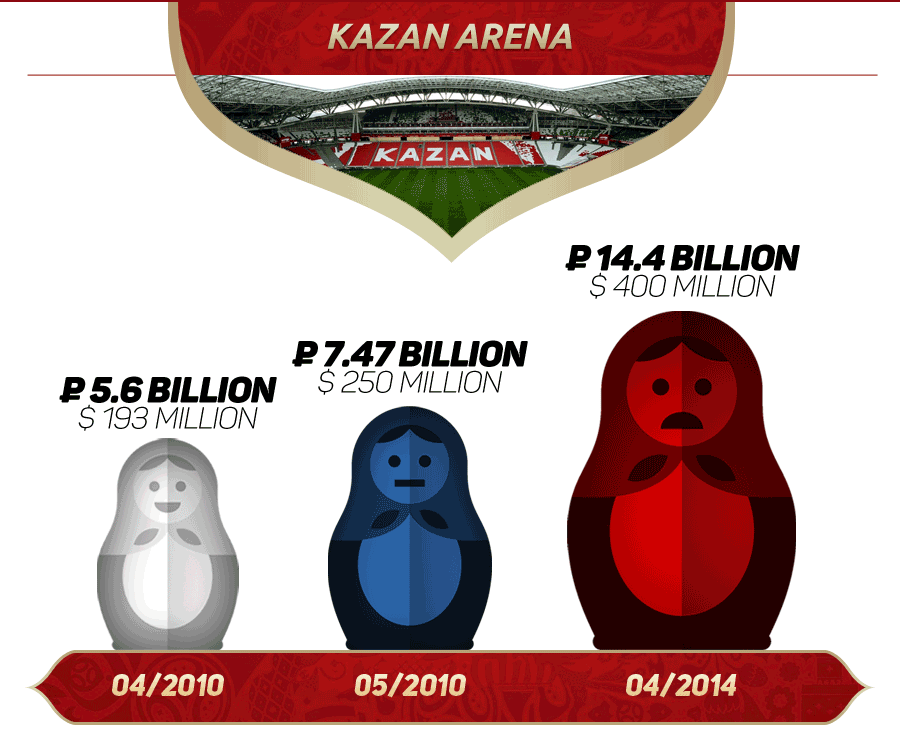
Tatarstan's biggest and best stadium is one of the very few which saw groundbreaking before FIFA's evaluation of the Russian bid. In fact, it was a proof of how serious the Russian bid is, even if it was being built primarily for the 2013 Universiade.
At the time of early ground works in 2010 local officials were publicly suggesting a price tag of mere 5.5 to 5.6 billion ruble, surprisingly low for a stadium of 45,000. Even the official 2018 bid book listed the price as RUB 7.5 billion. Even that was unrealistic for a stadium with elaborate roof structure weighing massive 12,000 tons! Did we mention Europe's largest stadium media facade?
Actual cost from the very start seemed much closer to the RUB 10-12 billion level and eventually in April of 2014 sports minister Vitaly Mutko confirmed that RUB 14.4 billion had been spent. While irregularities were being reported, in this case the main cause for price increase seems to be the rush to deliver the stadium in time for Universiade.
Fisht Stadium | Sochi
Price increase: +319%
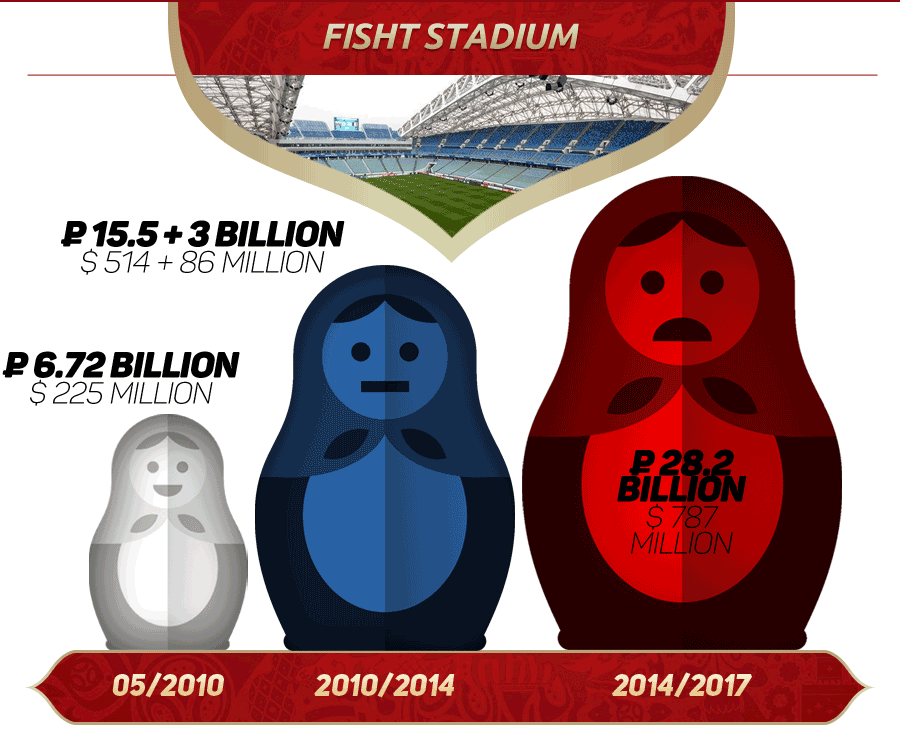
The Sochi project is one of two most compromised and ridiculed across Russia. In the official FIFA bid Russia suggested a price tag of $225 million (RUB 6.72 bn). But already that same year, when work on site began, the price was suggested to be well above RUB 10 billion, later capped with a limit of 15.5 billion.
Well, that limit didn't last long. The stadium's budget swelled to 18 billion and eventually reached a confirmed height of 23.5 billion. Why the massive increase? There was a number of issues leading to it and if you're guessing corruption might be involved, you may as well be right.
But even if it was (we were unable to verify that), the largest cause of increase may have been late changes into the stadium design, which were confirmed by Populous. The roof was initially designed as a rather light structure, based on two main arches. However, as the main venue for 2014 Olympics, the stadium was reconsidered to have a temporary roof above the playing field as well, weighing thousands of tons itself. This required a significantly more massive truss structure, which eventually ended up at hard to imagine 22,000 tons, which may be considered a record for a stadium of this scale.
Another important reason, possibly more prone to corruption, was the messy preparation for opening and closing ceremonies of the Olympics, for which the stadium had to be configured in specific ways.
Finally, the stadium went through a second construction period after the 2014 games, when auditorium behind the goals was added. First announced to cost just RUB 3 billion, it then went up to 3.5, then to 4 and finally reached 4.7 billion. In total this means a stunning 28.2 billion in public spending, far above market price for a stadium of this size and quality.
Spartak Stadium | Moscow
Price increase: +67%
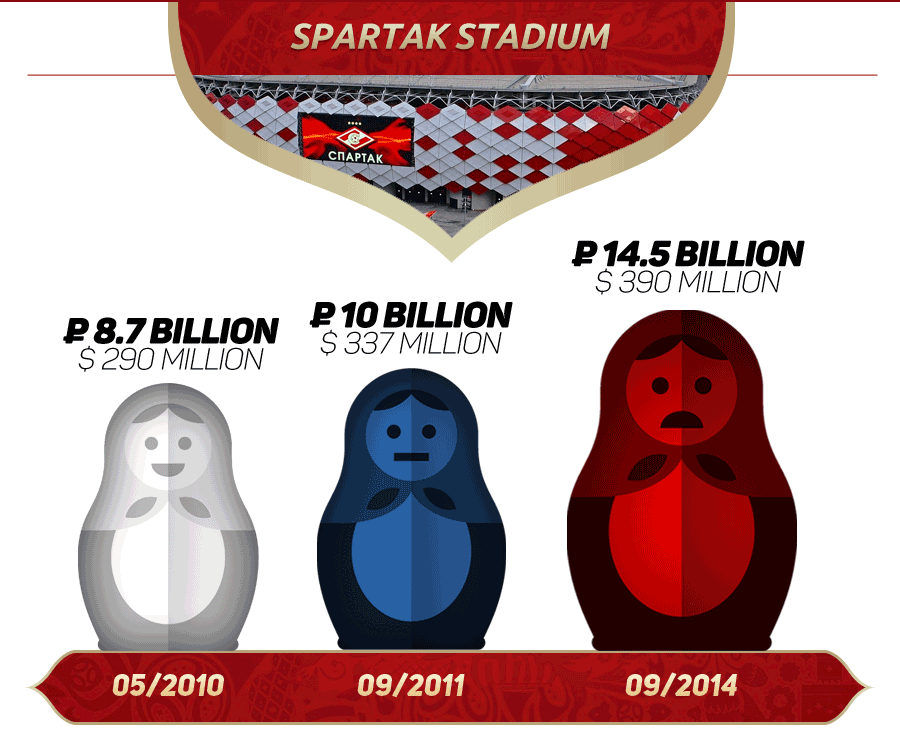
It's the only private stadium delivered before the 2018 World Cup. Investment by billionaire Leonid Fedun was in fact expected to be delivered well before, but it was halted due to the 2008 global economic crisis. Already in the 2010 Russian bid book it had the highest price tag of all group-phase stadiums at $290 million.
It soon proved that such estimate is still optimistic. By 2011, when ground works and foundations were nearly done, Fedun's brother in charge of the stadium project, confirmed it was expected to cost RUB 10 billion. It later turned out that even that was far below final cost, confirmed at 14.5 billion.
Saint Petersburg Stadium | St. Petersburg
Price increase: +542%
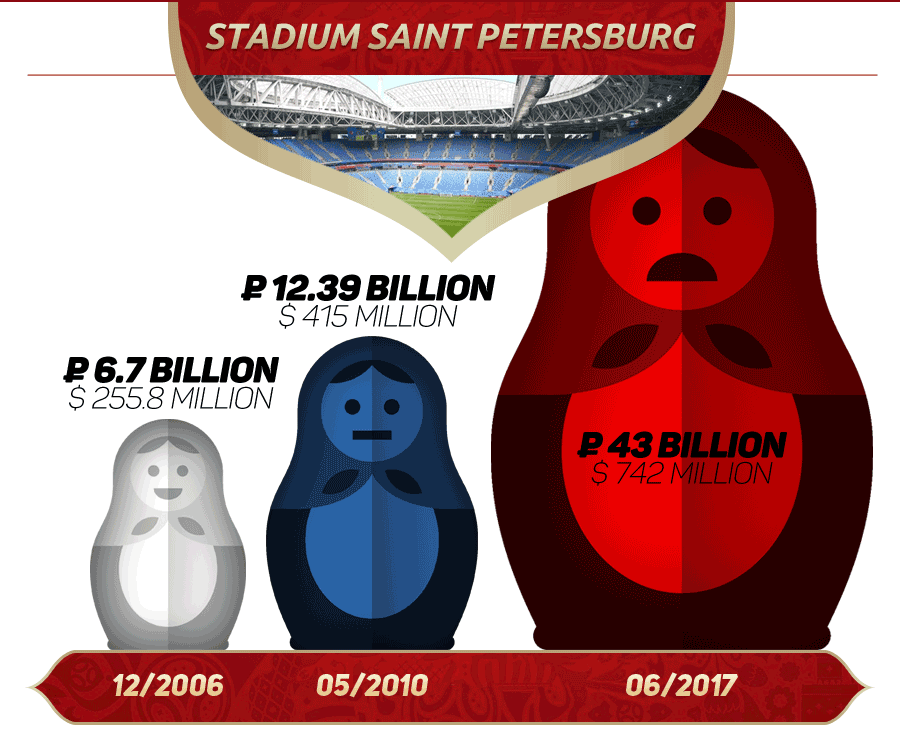
Yes, you're seeing the number right! Additional 542% had to be added on top of the stadium's initial budget and we're really being generous by giving this number. Because in this stadium's case, due to the irrationally long process of delivery, we actually used the price from groundbreaking (RUB 6.7 bn) as our starting estimate, while there was an even lower figure before, when the stadium was announced as a design, worth supposedly some RUB 4.1 billion.
Also, we should note that the official final estimate of 43 billion is also not the highest one we could find. Unofficial estimates put the stadium much closer to the 50 billion barrier, truly hard to imagine.
How could anything like that even happen, a stadium being built almost 11 years and having its cost increase roughly 6 times? In Piter nothing went along plan and we mean mistakes from the very, very start. The selected winning project was a beautiful one, but proved unsuitable for the northern city's harsh climate, whether we consider the membrane retractable roof or semi-open seating bowl exposing fans to high winds. Then the stadium's designer died and Russian counterparts proved unable to find optimal ways of redesigning the giant.
As a result there were areas of the stadium that were built and then had to be demolished and rebuilt once more. Hundreds of significant changes to the design were included and changes also took place at the construction site. Three general contractors went through the stadium and our guess is none of them have good memories from Krestovsky Ostrov.
And even after over a decade under construction we're still waiting for further repairs after the World Cup concludes. The stadium remains impressive visually but it's a rare case where you may see mistakes being made every step of the way, ending in courts at present. Were it not for the collapse of Russian currency, it would have been among the most expensive stadia ever built.
Luzhniki Stadium | Moscow
Price increase: +269%
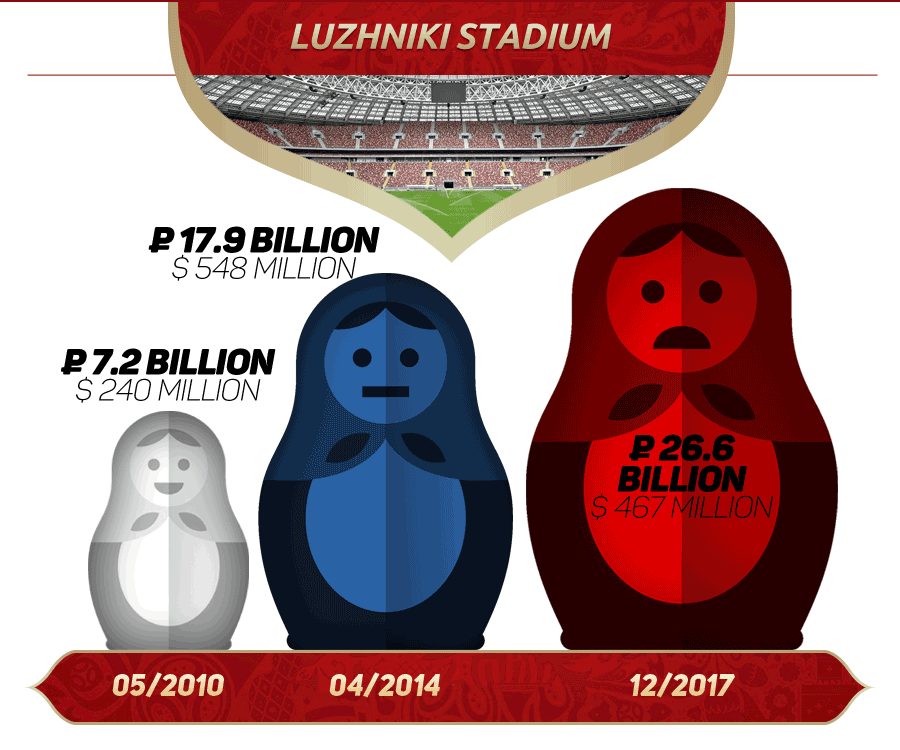
When you look at what the Russian bid included with regard to the national stadium, it seems laughable in hindsight. Just $240 million for complete reconstruction and capacity comparable to Wembley? No way, as proven in real life.
But having criticised the initial estimates from 2010, we have to commend the two latter, much higher figures. Even when we include the capacity reduction of almost 10,000, which made the reconstruction possible in the first place (larger auditorium simply wouldn't fit within the old walls and roof).
Luzhniki's complete reconstruction was contracted for RUB 17.9 billion early into the economic downturn in Russia. Soon after signing of the contract it was clear that it's impossible to do the work below 20 billion and the sums kept swelling later on. But we should point your eyes to the value expressed in US$, which shows how much the ruble has plummeted.
In fact the revamp was quite disciplined both in terms of timing and financing, while quality of the delivered stadium is more than satisfactory. That's not the case for all stadia of the World Cup.
Ekaterinburg Arena | Yekaterinburg
Price increase: +174%
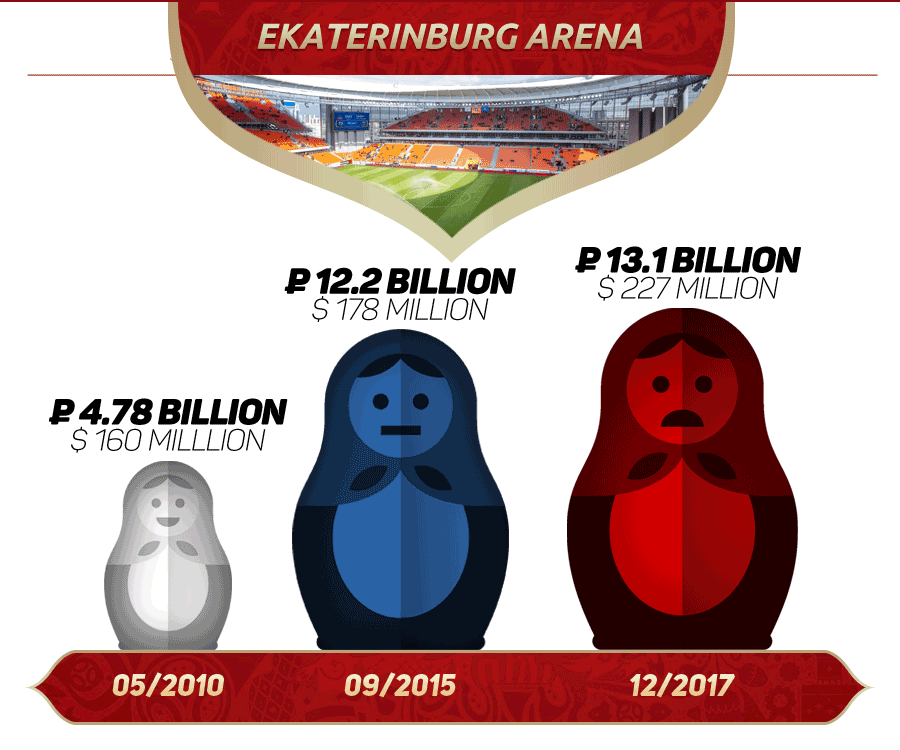
According to the 2010 World Cup bid this was to be the very cheapest stadium of the World Cup. Well, that part remains true today, it is the cheapest stadium by total budget. However actual price is hardly comparable to the optimistic $160 million (RUB 4.78bn) of 2010.
By 2015 the price tag reached 12.2 billion and that increase came despite stadium capacity being conditionally lowered to just 35,000. Smaller and more expensive, sure. But the stadium isn't among Russia's most controversial stadium expenditures by any account. Price increases despite the economic climate proved constrained in the end.
Rostov Arena | Rostov-on-Don
Price increase: +201%
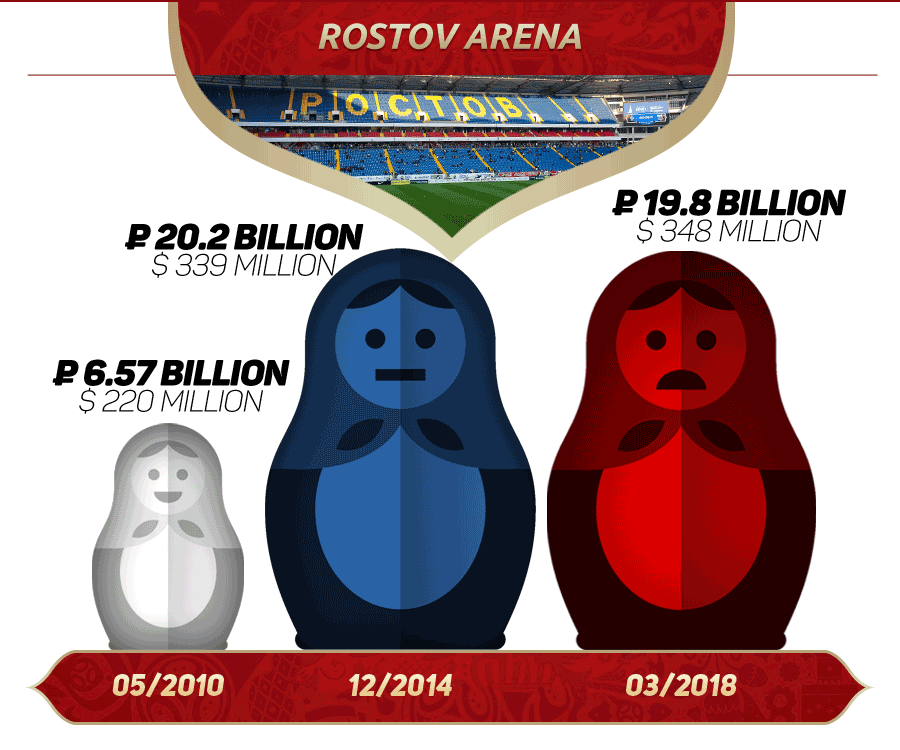
In Rostov location of the stadium on Don's left bank was set from the very start, though the architectural concept presented to FIFA was just preliminary. However, the city was one of the first to get the final design, already in 2011. Delivered by Populous, it was quite impressive. Fluid and irregular form of the stadium, with spacious canopy and public areas, connected to multi-level parking and built-in indoor hall.
Enough to impress, but also enough to see budget explode once construction was actually about to start during the economic crisis. In the case of Rostov too ambitious initial plan was the main cause for cost increase. Upon contract signing Crocus Group warned it would blow to over 20 billion and a number of interventions was made.
In fact, that number and scale of cost-cutting measures proved so large, that almost nothing was left of the initial vision. Stands, roof, surroundings – everything was simplified to the extent that you wouldn't connect the final stadium with what was supposed to be built.
On the one hand, it's the only case of a Russian World Cup stadium being built for less than suggested upon groundbreaking. On the other, the cost was still close to 20 billion and the investment resulted in a completely different, far less functional stadium.
Kaliningrad Stadium | Kaliningrad
Price increase: +195%
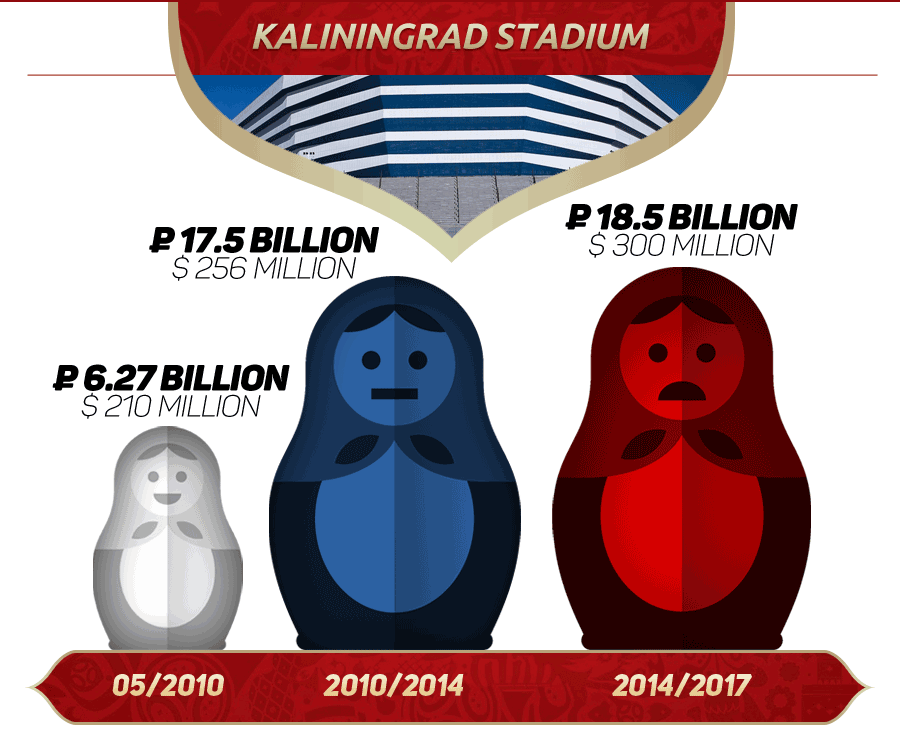
We've dedicated a separate article to the extent of changes between initial and final design of this stadium, so now let's just mention that the the case of Oktyabrskyi Ostrov stadium is as muddy as the island itself. Suggesting a 45,000-seat stadium to be built in a swampy wetland area for just $210 million was surely a mistake on behalf of the Russian organisers.
It wasn't realistic already in 2010 and it's thus no wonder that the budget swelled from RUB 7 to 11 billion before design change. When Crocu Group finally took control of the site in 2015, it was already 17.5 billion. At the time of writing this the price is thought to be beyond 18 billion (with as much as 500 million spent on illegal activity, according to ongoing investigation), which itself isn't a problem. The problem is: for 18 billion Kaliningrad received the smallest and most simplistic stadium, which makes the price too high. Legacy-wise the reduced capacity is a good step, just not at that price.
Nizhny Novgorod Stadium | Nizhny Novgorod
Price increase: +146%
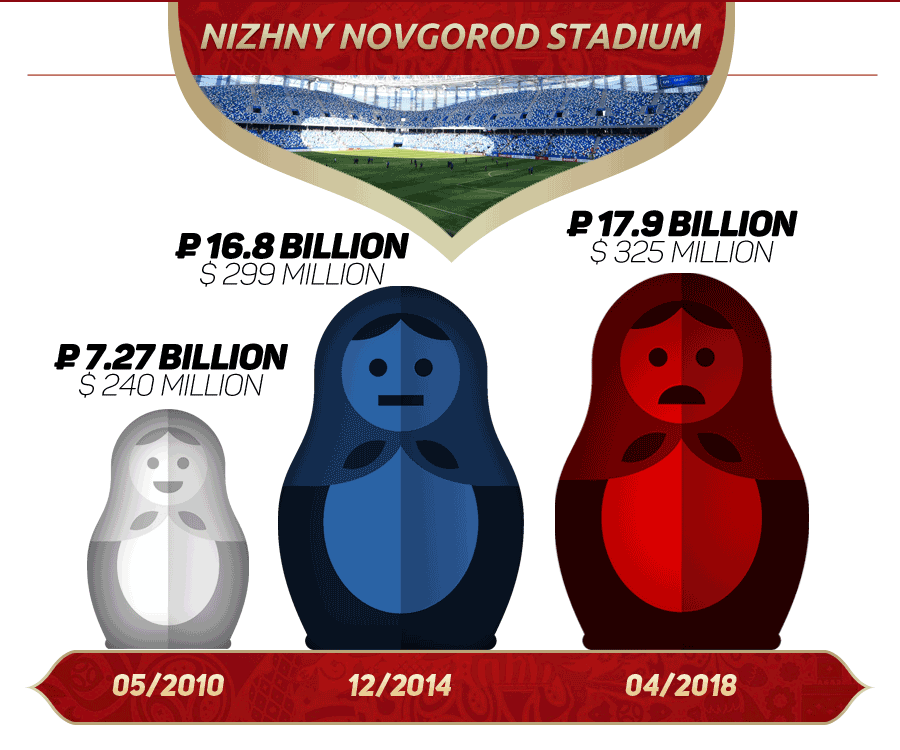
Back in 2010 this stadium was supposed to cost $240 million, except it wasn't this stadium. A far more remote location was proposed, which proved not viable eventually, just like in Samara. The selection of Strelka as final stadium site is undoubtedly far better in terms of accessibility.
When the new stadium concept was presented in 2013, Russia was still in relatively good shape. Thus the majestic whirlpool stadium design and rather high starting price (for 2013) of RUB 12 billion. As the currency collapsed, general contractor was refusing to agree on construction for similar amount, only having agreed upon 16.8 billion. Even that was well below Stroytransgaz's estimate of 18-20 billion. To compromise, a number of concessions have been made and the company was able to simplify the stadium to some extent.
We have to say that, despite having lost its wavy glazed facade, the stadium retained a lot of its initial quality and the interventions seem rather successful, not diminishing main qualities or the stadium's actual size.
Mordovia Arena | Saransk
Price increase: +215%
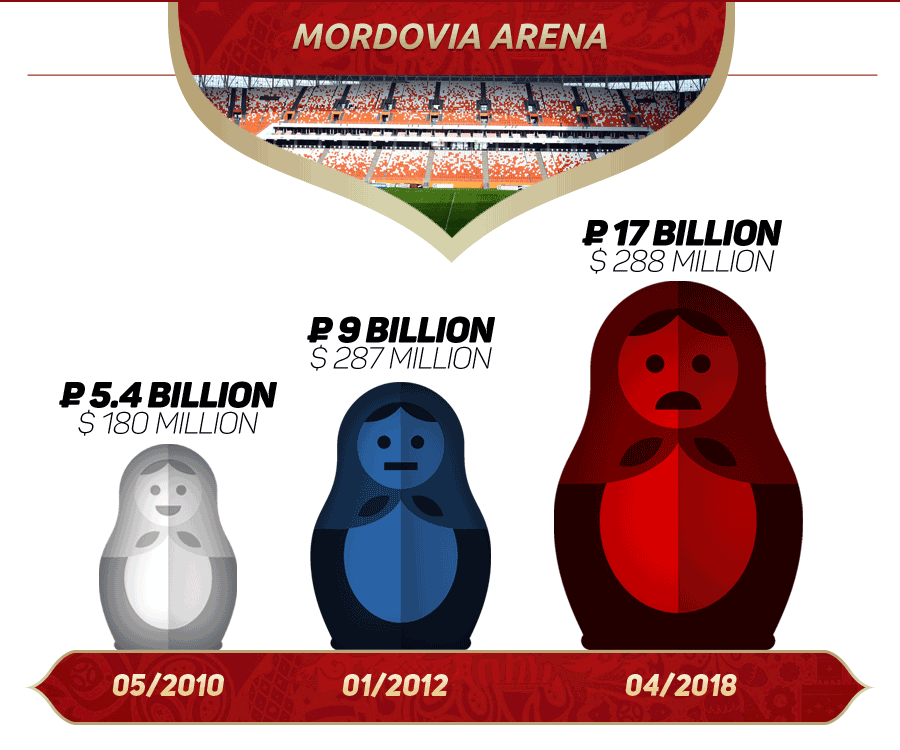
It was supposed to be one of the cheapest stadiums of the World Cup, according to Russia's 2010 promise to FIFA. Which makes little sense – it wasn't smaller than others and was also supposed to be built on shaky ground beside the river Insar, forcing costly piling works. That's why we find the initial optimism far more surprising than eventual cost increases.
Construction of this stadium was one of the first to begin, back in 2010. However at that time works were financed by the authorities in Mordovia. Early into the foundation phase works were stopped, the project was transferred to federal authorities, design changes began taking place.
These steps alone, connected to lengthy periods of works on site being deadlocked, vastly increased the stadium's price. Eventually, as the crisis progressed, cost-cutting efforts were made, above all the stadium's roof structure was completely redesigned to become simple and less impressive. Still interesting, though.
Volgograd Arena | Volgograd
Price increase: +171%
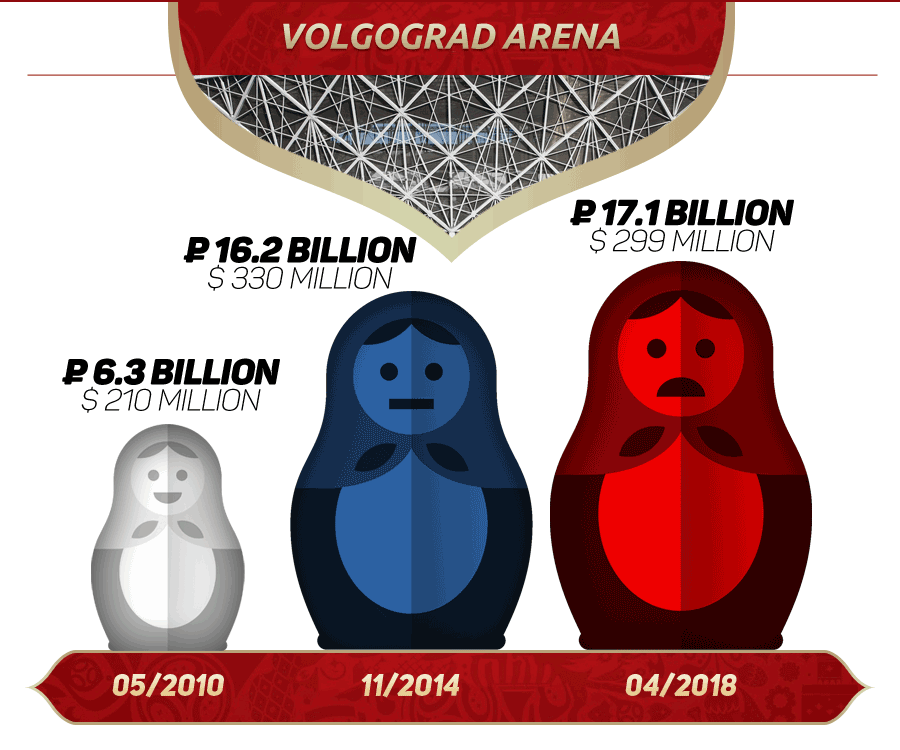
Contrary to some other cities, in Volgograd the stadium site was selected from the start and the venue's size hasn't changed despite turbulent economic conditions. This becomes remarkable as construction in Volgograd only began during the crisis and yet the delivered stadiums is almost exactly as it was initially planned. Only minor interventions into the design were made and none of the most problematic features, like imported cable roof or the elaborate, thick steel facade, were replaced with cheaper solutions.
Increase in price between 2010 and delivery is still very high, however it's one more case where the initial estimate is more controversial than the final price. We have to commend Stroytransgaz for the value for money of delivered infrastructure and consistency with initial expectations.
Samara Arena | Samara
Price increase: +250%
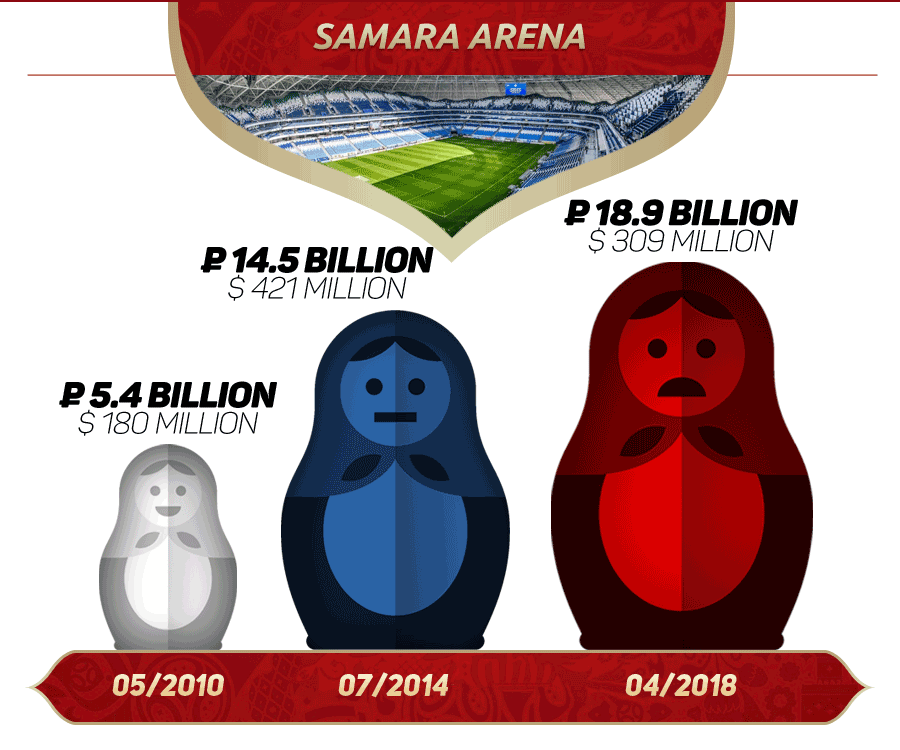
The stadium for Samara was suggested in 2010 to grow on Cow Island, a completely unconnected and uninhabited marshy island in the west of the city. That would have been extremely problematic and surely far more expensive than the suggested price of just $180 million. It was bound to change and change it did.
New concept of a cosmic dome in the north east was drawn, perhaps even too profound. The second matryoshka doll in Samara's graphic comes at a very interesting moment. The 14.5 billion was the sports ministry's last estimate before the ruble crash of 2014 and before groundbreaking. Early into actual construction the general contractor warned that delivery of the exact planned stadium would cost a mindblowing 28 billion.
We were unable to verify whether this estimate was correct, however it surely worked the trick: a number of cost-cutting efforts were made. We've covered how the cosmic dome was simplified and costly materials replaced with cheaper ones. Illumination was dropped from the scheme, among other things, and overall quality of the work delivered was questioned on a number of occasions. That said, the stadium is still iconic and stands out globally.
Advertisement
 StadiumDB
StadiumDB